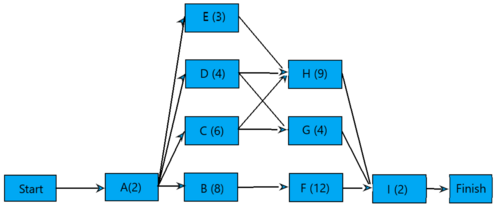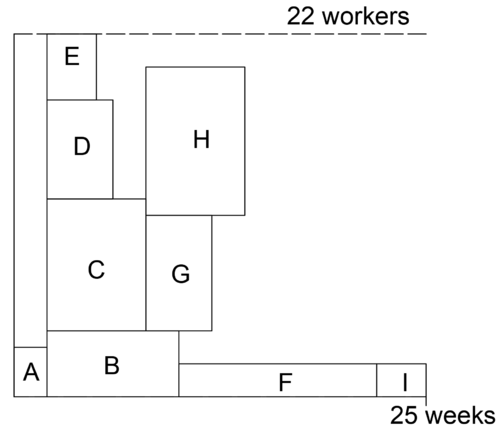Resource allocation and crashing
(→Resource loading) |
(→Resource loading) |
||
| Line 32: | Line 32: | ||
<gallery mode="packed-hover"> | <gallery mode="packed-hover"> | ||
| − | Image:Resourcetable.png| | + | Image:Resourcetable.png|''[[thumb|caption]]'' (Oscar) |
Image:ResourceAON.png|''[[commons:Astronotus ocellatus|Astronotus ocellatus]]'' (Oscar) | Image:ResourceAON.png|''[[commons:Astronotus ocellatus|Astronotus ocellatus]]'' (Oscar) | ||
Image:loading.png|''[[commons:Astronotus ocellatus|Astronotus ocellatus]]'' (Oscar) | Image:loading.png|''[[commons:Astronotus ocellatus|Astronotus ocellatus]]'' (Oscar) | ||
Revision as of 20:05, 21 February 2019
Created by Jesper Antonius Wolters
Contents |
Abstract
Common to all projects is the need to allocate available resources in the best possible manner. Resources are not infinite and in order to obtain the most optimal result, they have to be allocated thoughtfully. If done correctly by the project manager, she can optimize the way the project uses it resources and minimize the negative effect of unforeseen events. However, if done casually, this might result in delays, penalty fees, using unnecessarily many resources on wrong events and not on critical events. From this article, the PM will learn techniques to help allocate resources efficiently in order to avoid the situations described above. In addition, by analyzing the possibility of crashing the project, the project manager might be able to find a more optimal solution than would be possible by the simple PERT/CPM analysis, this analysis thus builds upon a PERT/CPM analysis. This article aims at giving the reader a greater understanding of how to allocate resources to a project as well as presenting an example of how a project could be crashed. Three different techniques to resource allocation will be presented and explained in depth. Furthermore, in order to give the reader a greater understanding of how resource allocation can effect a project, positively as well as negatively, two examples using CPM crash heuristics will be presented.
Resource allocation
In project management, the term resource allocation covers the action of allocating resources to specific activities or people, in order to reach a goal set by the project manager. The project might have a limited amount of resources at any given point in time which challenges the project manager to make sure that resource capacity is neither wasted nor that extra resources need to be bought externally. By smoothing out the resource requirement over the life cycle of the project, it makes it easier to add a buffer, which in turn can help the project manager to avoid delays, expensive penalties for not meeting deadlines, the need for hiring extra personal and avoiding bad work ethic as a result of overtime. "One cannot save time - one can only spend more of less of it."
Resource loading
"Resource loading describes the amounts of individual resources an existing schedule requires during specific time periods." [1] As described in the abstract, the resource loading builds upon a CPM/PERT analysis. The resource loading technique includes the problem of resources whereas a CPM/PERT analysis assumes that there are infinite resources. [2] Assuming that a CPM analysis has been made and a Critical Path established, the first step of resource loading is to identify the types and quantities of resources, and spread them by a schedule across specific time periods. The aim is to identify and reduce excess demands on a company's resources. It is important to mention that by allocating twice as many resources to one activity does not mean that it will be completed in half the time originally planned. In order to better illustrate the challenges arising when including resource loading to a CPM/PERT analysis, a short example is presented. From figure 1, a simple project is presented and from the AON created on figure 2, the critical path is found to be ABFI Without taking resource loading into account, this might be enough to say that ABFI is the critical path, but by taking into account the amount of workers needed for each activity, the PM gets more insight into the resource required at a given point in time.
caption (Oscar)
Astronotus ocellatus (Oscar)
Astronotus ocellatus (Oscar)
Resource leveling
Resource scheduling
Crashing a project
Cost-time trade off
Advantages and disadvantages
Conclusion
Annotated bibliography
Fast tracked project Calculate
References
- ↑ Meredith, Jack and Mantel, Samuel (2009) "Project management a managerial approach 7th Edition
- ↑ https://digitalcommons.calpoly.edu/cgi/viewcontent.cgi?referer=https://www.google.com/&httpsredir=1&article=1076&context=cmsp
- ↑ dr. ir. Broekmeulen. Rob "Slides from course 1CM900 Project Management at Eindhoven University of Technology"
- ↑ Guide to the Project Management Body of Knowledge (PMBOK® Guide) (6th Edition) Chapter 6
- ↑ https://link-springer-com.proxy.findit.dtu.dk/content/pdf/10.1007%2F3-540-27852-4.pdf
- ↑ https://www.sciencedirect.com/science/article/pii/S0377221799004907
- ↑ http://www.ijept.org/index.php/ijept/article/viewFile/Resource_Allocation_in_Project_Management/pdf






